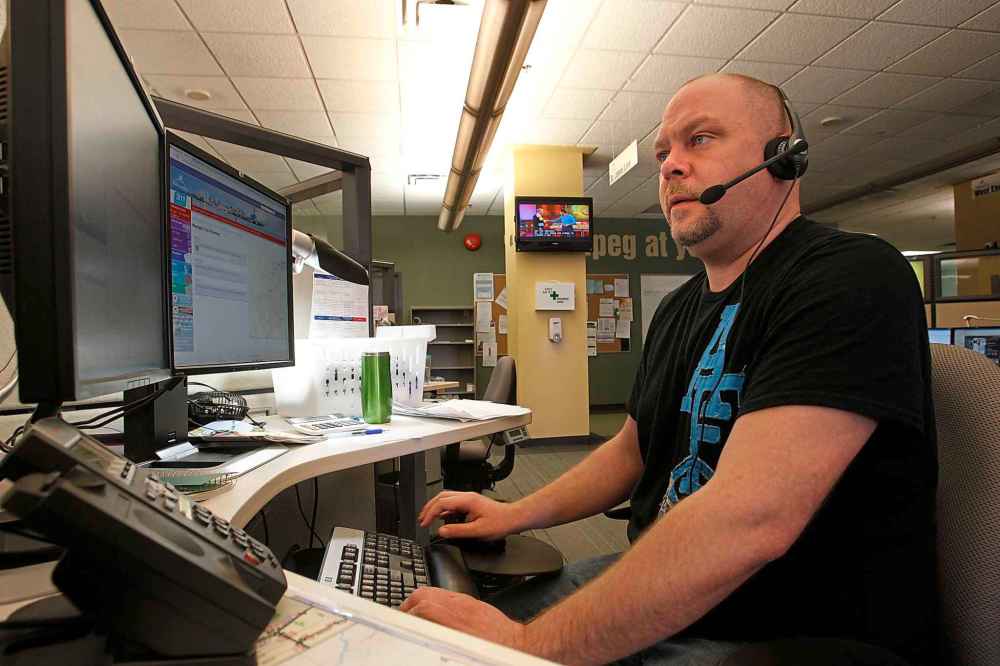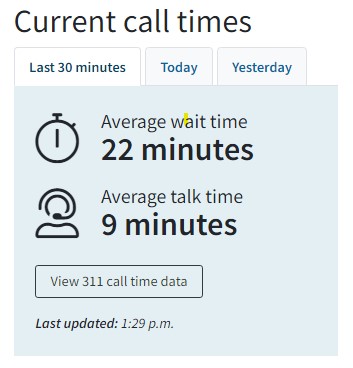City’s 311 lets callers know how long they’ll wait
Advertisement
Read this article for free:
or
Already have an account? Log in here »
To continue reading, please subscribe:
Monthly Digital Subscription
$0 for the first 4 weeks*
- Enjoy unlimited reading on winnipegfreepress.com
- Read the E-Edition, our digital replica newspaper
- Access News Break, our award-winning app
- Play interactive puzzles
*No charge for 4 weeks then price increases to the regular rate of $19.00 plus GST every four weeks. Offer available to new and qualified returning subscribers only. Cancel any time.
Monthly Digital Subscription
$4.75/week*
- Enjoy unlimited reading on winnipegfreepress.com
- Read the E-Edition, our digital replica newspaper
- Access News Break, our award-winning app
- Play interactive puzzles
*Billed as $19 plus GST every four weeks. Cancel any time.
To continue reading, please subscribe:
Add Free Press access to your Brandon Sun subscription for only an additional
$1 for the first 4 weeks*
*Your next subscription payment will increase by $1.00 and you will be charged $16.99 plus GST for four weeks. After four weeks, your payment will increase to $23.99 plus GST every four weeks.
Read unlimited articles for free today:
or
Already have an account? Log in here »
Hey there, time traveller!
This article was published 05/07/2022 (1218 days ago), so information in it may no longer be current.
A new online tool will help callers to the city’s 311 service better predict how long they’ll spend on hold.
After months of soaring wait times to connect with the city information service, a “real-time” tracker shares the average wait that occurred during the previous 30 minutes on the city’s web page.
The “current call times” tab is updated every five minutes, while viewers can also click on “today” and “yesterday” tabs to discover how long folks waited over the past several hours or previous day.

“By having that call data available in real time… maybe this will help (residents) make a decision on when (it is) best to call. If you have something that’s less urgent in priority, you might be better to call later in the evening or earlier in the morning,” said Felicia Wiltshire, the city’s director of customer service and communications.
Wait times mostly ranged from 20 minutes to 35 minutes between 9 a.m. and noon Tuesday. Monday’s data showed little to no wait between 1 a.m. and 7 a.m. and peaked at 57 minutes just before 4:30 p.m.
Wiltshire said it’s too soon to tell if people are changing the times they choose to call 311 based on the newly shared information, which the city began posting online last week. She said requests for this type of data have become common.
“Increasingly… not only were people asking more frequently about the wait time at 311 but also just starting to ask about when (it) is the best time to call,” said Wiltshire.
311 was designed to be a convenient first point of contact for Winnipeggers to file complaints or request information about city services.
But the time to reach 311 skyrocketed in 2021, leading many residents to complain it is no longer practical. The longest wait times for calls exceeded two hours.
The average call wait time for the 24/7 service surged to 11 minutes and 42 seconds last year, up from 2:56 in 2019 and 5:27 in 2020, a recent city report showed. The average amount of time spent to handle each call also rose, to 6:14 in 2021 from 5:13 in 2019.
The city has blamed the extensive waits on increasingly complex calls, frequent staff turnover and an increased number of email and social media interactions that 311 agents must also answer.
Wiltshire said unexpected events can also lead to sudden spikes in demand, such as the heavy rainstorm that flooded many city streets on June 24.
“Wait times at 311 just spiked almost instantly when that heavy rain event happened,” she said.
The city received 122 calls due that evening, which were prioritized in a water and sewer emergency queue. Those calls had an average wait time that ranged from between 18 and 32 minutes from 7 p.m. to 8:30 p.m. The average wait times for unrelated calls ranged from 39 minutes to 1 hour and 22 minutes during the same period.
The city’s website also shares average talk times per call. However, Wiltshire said the city is not working to reduce the length of individual calls because its top priority is to answer all questions as thoroughly as possible.

Coun. Janice Lukes, who has long pushed for improvements to 311, said the new data is worth sharing but may not help many residents avoid long waits. That’s because the best times to call appear to occur after 10 p.m. and before 7 a.m., she said.
“If people have very flexible schedules, that is positive, (but) that doesn’t mean a lot. There’s still a fundamental disconnect from the front end (of 311) to the back end (of city departments),” said Lukes.
The councillor said city departments can rely on different software and often lack efficient ways to share data, including updates to 311 requests. When those challenges combine with lengthy wait times, some residents will give up trying to get answers through 311 and call their city councillor instead, she said.
“It puts added pressure on anyone that they can phone. I’d say a quarter of my job is 311 work,” said Lukes.
The online dashboard is part of a broader effort to revamp 311, which was released a few months ago. The city expects to post information on “call drivers” next.
An April report noted the city will also review the starting wage for entry-level positions at 311 and flexible (work-from-home) options, with the goal of better retaining staff. The number of full-time 311 positions fell from 105 in 2019, to 80 in 2020, and 75 in 2021.
311 wait times are now posted at https://winnipeg.ca/311/default.asp#contact-311
joyanne.pursaga@freepress.mb.ca
Twitter: @joyanne_pursaga

Joyanne is city hall reporter for the Winnipeg Free Press. A reporter since 2004, she began covering politics exclusively in 2012, writing on city hall and the Manitoba Legislature for the Winnipeg Sun before joining the Free Press in early 2020. Read more about Joyanne.
Every piece of reporting Joyanne produces is reviewed by an editing team before it is posted online or published in print — part of the Free Press‘s tradition, since 1872, of producing reliable independent journalism. Read more about Free Press’s history and mandate, and learn how our newsroom operates.
Our newsroom depends on a growing audience of readers to power our journalism. If you are not a paid reader, please consider becoming a subscriber.
Our newsroom depends on its audience of readers to power our journalism. Thank you for your support.
History
Updated on Tuesday, July 5, 2022 5:35 PM CDT: Adds images.

